
Fungus-growing ants comprise all the known fungus-growing ant species participating in ant–fungus mutualism. They are known for cutting grasses and leaves, carrying them to their colonies' nests, and using them to grow fungus on which they later feed.

Messor is a myrmicine genus of ants with more than 100 species, all of which are harvester ants; the generic name comes from the Roman god of crops and harvest, Messor. The subterranean colonies tend to be found in open fields and near roadsides, openings are directly to the surface.
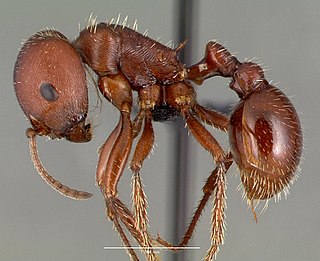
Pogonomyrmex barbatus is a species of harvester ant from the genus Pogonomyrmex. Its common names include red ant and red harvester ant. These large ants prefer arid chaparral habitats and are native to the Southwestern United States. Nests are made underground in exposed areas. Their diets consist primarily of seeds, and they consequently participate in myrmecochory, an ant-plant interaction through which the ants gain nutrients and the plants benefit through seed dispersal. Red harvester ants are often mistaken for fire ants, but are not closely related to any fire ant species, native or introduced.
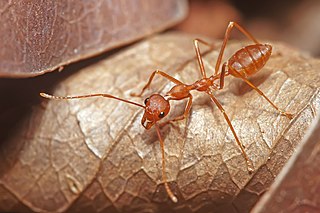
Weaver ants or green ants are eusocial insects of the family Formicidae. Weaver ants live in trees and are known for their unique nest building behaviour where workers construct nests by weaving together leaves using larval silk. Colonies can be extremely large consisting of more than a hundred nests spanning numerous trees and containing more than half a million workers. Like many other ant species, weaver ants prey on small insects and supplement their diet with carbohydrate-rich honeydew excreted by small insects (Hemiptera). Weaver ant workers exhibit a clear bimodal size distribution, with almost no overlap between the size of the minor and major workers. The major workers are approximately 8–10 mm (0.31–0.39 in) in length and the minors approximately half the length of the majors. Major workers forage, defend, maintain, and expand the colony whereas minor workers tend to stay within the nests where they care for the brood and 'milk' scale insects in or close to the nests.

The pharaoh ant is a small (2 mm) yellow or light brown, almost transparent ant notorious for being a major indoor nuisance pest, especially in hospitals. A cryptogenic species, it has now been introduced to virtually every area of the world, including Europe, the Americas, Australasia and Southeast Asia. It is a major pest in the United States, Australia, and Europe.
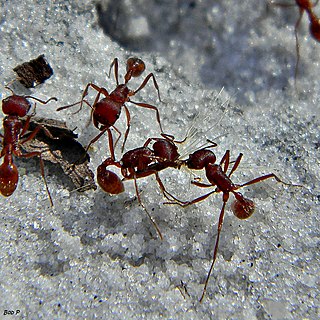
Harvester ant, also known as harvesting ant, is a common name for any of the species or genera of ants that collect seeds, or mushrooms as in the case of Euprenolepis procera, which are stored in the nest in communal chambers called granaries. They are also referred to as agricultural ants. Seed harvesting by some desert ants is an adaptation to the lack of typical ant resources such as prey or honeydew from hemipterans. Harvester ants increase seed dispersal and protection, and provide nutrients that increase seedling survival of the desert plants. In addition, ants provide soil aeration through the creation of galleries and chambers, mix deep and upper layers of soil, and incorporate organic refuse into the soil.

The name army ant (or legionary ant or marabunta) is applied to over 200 ant species in different lineages. Because of their aggressive predatory foraging groups, known as "raids", a huge number of ants forage simultaneously over a limited area.

Eciton burchellii is a species of New World army ant in the genus Eciton. This species performs expansive, organized swarm raids that give it the informal name, Eciton army ant. This species displays a high degree of worker polymorphism. Sterile workers are of four discrete size-castes: minors, medias, porters (sub-majors), and soldiers (majors). Soldiers have much larger heads and specialized mandibles for defense. In lieu of underground excavated nests, colonies of E. burchellii form temporary living nests known as bivouacs, which are composed of hanging live worker bodies and which can be disassembled and relocated during colony emigrations. Eciton burchellii colonies cycle between stationary phases and nomadic phases when the colony emigrates nightly. These alternating phases of emigration frequency are governed by coinciding brood developmental stages. Group foraging efforts known as "raids" are maintained by the use of pheromones, can be 200 metres (660 ft) long, and employ up to 200,000 ants. Workers are also adept at making living structures out of their own bodies to improve efficiency of moving as a group across the forest floor while foraging or emigrating. Workers can fill "potholes" in the foraging trail with their own bodies, and can also form living bridges. Numerous antbirds prey on the Eciton burchellii by using their raids as a source of food. In terms of geographical distribution, this species is found in the Amazon jungle and Central America.
Task allocation and partitioning is the way that tasks are chosen, assigned, subdivided, and coordinated within a colony of social insects. Task allocation and partitioning gives rise to the division of labor often observed in social insect colonies, whereby individuals specialize on different tasks within the colony. Communication is closely related to the ability to allocate tasks among individuals within a group. This entry focuses exclusively on social insects. For information on human task allocation and partitioning, see division of labour, task analysis, and workflow.

Acromyrmex is a genus of New World ants of the subfamily Myrmicinae. This genus is found in South America and parts of Central America and the Caribbean Islands, and contains 33 known species. Commonly known as "leafcutter ants" they comprise one of the two genera of advanced attines within the tribe Attini, along with Atta.

The green-head ant is a species of ant that is endemic to Australia. It was described by British entomologist Frederick Smith in 1858 as a member of the genus Rhytidoponera in the subfamily Ectatomminae. These ants measure between 5 and 7 mm. The queens and workers look similar, differing only in size, with the males being the smallest. They are well known for their distinctive metallic appearance, which varies from green to purple or even reddish-violet. Among the most widespread of all insects in Australia, green-head ants are found in almost every Australian state, but are absent in Tasmania. They have also been introduced in New Zealand, where several populations have been established.

Pogonomyrmex occidentalis, or the western harvester ant, is a species of ant that inhabits the deserts and arid grasslands of the American West at or below 6,300 feet (1,900 m). Like other harvester ants in the genus Pogonomyrmex, it is so called because of its habit of collecting edible seeds and other food items. The specific epithet "occidentalis", meaning "of the west", refers to the fact that it is characteristic of the interior of the Western United States; its mounds of gravel, surrounded by areas denuded of plant life, are a conspicuous feature of rangeland. When numerous, they may cause such loss of grazing plants and seeds, as to constitute both a severe ecological and economic burden. They have a painful and venomous sting.

Formica truncorum is a species of wood ant from the genus Formica. It is distributed across a variety of locations worldwide, including central Europe and Japan. Workers can range from 3.5 to 9.0mm and are uniquely characterized by small hairs covering their entire bodies. Like all other ants, F. truncorum is eusocial and demonstrates many cooperative behaviors that are unique to its order. Colonies are either monogynous, with one queen, or polygynous, with many queens, and these two types of colonies differ in many characteristics.
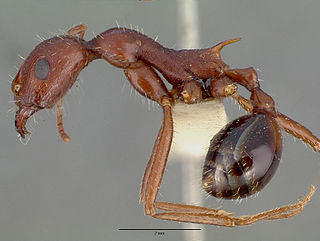
Novomessor cockerelli is a species of ant in the subfamily Myrmicinae. It is native to the deserts of the Southwestern United States and Mexico. It lives in large underground colonies in which there is a single queen. The worker ants leave the nest daily to forage for seeds, plant material and dead insects.

Polybia sericea is a social, tropical wasp of the family Vespidae that can be found in South America. It founds its colonies by swarming migrations, and feeds on nectar and arthropods.

Megaponera analis is the sole species of the genus Megaponera. They are a strictly termite-eating (termitophagous) ponerine ant species widely distributed in Sub-Saharan Africa and most commonly known for their column-like raiding formation when attacking termite feeding sites. Their sophisticated raiding behaviour gave them the common name Matabele ant after the Matabele tribe, fierce warriors who overwhelmed various other tribes during the 1800s. With some individuals reaching up to 25 millimetres (0.98 in) in length, M. analis is one of the world's largest ants.

Pogonomyrmex badius, or the Florida harvester ant, is a species of harvester ant in the genus Pogonomyrmex. It is the only Pogonomyrmex species found on the east coast of the United States and the only one in North America known to be polymorphic. The Florida Harvester ant is commonly found in Florida scrub and other similar habitats within the Atlantic coastal plain states.

Temnothorax rugatulus is a species of ant in the genus Temnothorax. It is found in North America. More specifically, it is found in the forests of the western United States. Colonies are either monogynous or polygynous. Queens in monogynous colonies are generally larger (marcogynes), about twice the size of conspecific workers; polygynous colonies have smaller queens (microgynes), typically slightly smaller than the workers. T. rugatulus ants are a subdominant ant group.
This is a glossary of terms used in the descriptions of ants.
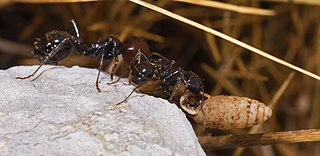
Messor capitatus is an ant species part of the genus Messor. This genus includes about 40 specialized species that are found in dry areas of Mediterranean countries such as Africa, Southern Europe, and Asia.Messor capitatus are known as an Old World species because they release trail pheromones from the Dufour gland instead of from poison glands. Messor capitatus are known as individual foragers that collect food independently of one another but sometimes will also use group foraging to form irregular, broad columns. Messor capitatus main food source is seeds but they also will eat remains of plants and animals.



















